Enkephalin elevations contribute to neuronal and behavioral impairments in a transgenic mouse model of Alzheimer's disease
- PMID: 18463254
- PMCID: PMC3315282
- DOI: 10.1523/JNEUROSCI.0590-08.2008
Enkephalin elevations contribute to neuronal and behavioral impairments in a transgenic mouse model of Alzheimer's disease
Abstract
The enkephalin signaling pathway regulates various neural functions and can be altered by neurodegenerative disorders. In Alzheimer's disease (AD), elevated enkephalin levels may reflect compensatory processes or contribute to cognitive impairments. To differentiate between these possibilities, we studied transgenic mice that express human amyloid precursor protein (hAPP) and amyloid-beta (Abeta) peptides in neurons and exhibit key aspects of AD. Met-enkephalin levels in neuronal projections from the entorhinal cortex and dentate gyrus (brain regions important for memory that are affected in early stages of AD) were increased in hAPP mice, as were preproenkephalin mRNA levels. Genetic manipulations that exacerbate or prevent excitotoxicity also exacerbated or prevented the enkephalin alterations. In human AD brains, enkephalin levels in the dentate gyrus were also increased. In hAPP mice, enkephalin elevations correlated with the extent of Abeta-dependent neuronal and behavioral alterations, and memory deficits were reduced by irreversible blockade of mu-opioid receptors with the antagonist beta-funaltrexamine. We conclude that enkephalin elevations may contribute to cognitive impairments in hAPP mice and possibly in humans with AD. The therapeutic potential of reducing enkephalin production or signaling merits further exploration.
Figures
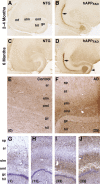

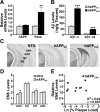
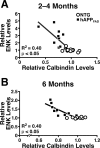
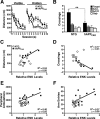
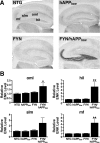
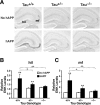
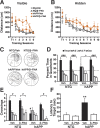
Similar articles
-
Aberrant excitatory neuronal activity and compensatory remodeling of inhibitory hippocampal circuits in mouse models of Alzheimer's disease.Neuron. 2007 Sep 6;55(5):697-711. doi: 10.1016/j.neuron.2007.07.025. Neuron. 2007. PMID: 17785178 Free PMC article.
-
Neuronal depletion of calcium-dependent proteins in the dentate gyrus is tightly linked to Alzheimer's disease-related cognitive deficits.Proc Natl Acad Sci U S A. 2003 Aug 5;100(16):9572-7. doi: 10.1073/pnas.1133381100. Epub 2003 Jul 24. Proc Natl Acad Sci U S A. 2003. PMID: 12881482 Free PMC article.
-
Reelin depletion in the entorhinal cortex of human amyloid precursor protein transgenic mice and humans with Alzheimer's disease.J Neurosci. 2007 Mar 14;27(11):2727-33. doi: 10.1523/JNEUROSCI.3758-06.2007. J Neurosci. 2007. PMID: 17360894 Free PMC article.
-
Effects of CX3CR1 and Fractalkine Chemokines in Amyloid Beta Clearance and p-Tau Accumulation in Alzheimer's Disease (AD) Rodent Models: Is Fractalkine a Systemic Biomarker for AD?Curr Alzheimer Res. 2016;13(4):403-12. doi: 10.2174/1567205013666151116125714. Curr Alzheimer Res. 2016. PMID: 26567742 Review.
-
Epilepsy and cognitive impairments in Alzheimer disease.Arch Neurol. 2009 Apr;66(4):435-40. doi: 10.1001/archneurol.2009.15. Epub 2009 Feb 9. Arch Neurol. 2009. PMID: 19204149 Free PMC article. Review.
Cited by
-
Neurotoxicity of amyloid β-protein: synaptic and network dysfunction.Cold Spring Harb Perspect Med. 2012 Jul;2(7):a006338. doi: 10.1101/cshperspect.a006338. Cold Spring Harb Perspect Med. 2012. PMID: 22762015 Free PMC article. Review.
-
Many neuronal and behavioral impairments in transgenic mouse models of Alzheimer's disease are independent of caspase cleavage of the amyloid precursor protein.J Neurosci. 2010 Jan 6;30(1):372-81. doi: 10.1523/JNEUROSCI.5341-09.2010. J Neurosci. 2010. PMID: 20053918 Free PMC article.
-
Ablation of cellular prion protein does not ameliorate abnormal neural network activity or cognitive dysfunction in the J20 line of human amyloid precursor protein transgenic mice.J Neurosci. 2011 Jul 20;31(29):10427-31. doi: 10.1523/JNEUROSCI.1459-11.2011. J Neurosci. 2011. PMID: 21775587 Free PMC article.
-
Opioid growth factor and the treatment of human pancreatic cancer: a review.World J Gastroenterol. 2014 Mar 7;20(9):2218-23. doi: 10.3748/wjg.v20.i9.2218. World J Gastroenterol. 2014. PMID: 24605021 Free PMC article. Review.
-
Synaptic depression and aberrant excitatory network activity in Alzheimer's disease: two faces of the same coin?Neuromolecular Med. 2010 Mar;12(1):48-55. doi: 10.1007/s12017-009-8097-7. Epub 2009 Oct 17. Neuromolecular Med. 2010. PMID: 19838821 Free PMC article. Review.
References
-
- Amatniek JC, Hauser WA, DelCastillo-Castaneda C, Jacobs DM, Marder K, Bell K, Albert M, Brandt J, Stern Y. Incidence and predictors of seizures in patients with Alzheimer's disease. Epilepsia. 2006;47:867–872. - PubMed
-
- Blennow K, de Leon MJ, Zetterberg H. Alzheimer's disease. Lancet. 2006;368:387–403. - PubMed
-
- Bodnar RJ, Klein GE. Endogenous opiates and behavior: 2004. Peptides. 2005;26:2629–2711. - PubMed
Publication types
MeSH terms
Substances
Grants and funding
- P50 AG023501/AG/NIA NIH HHS/United States
- R01 NS041787-08/NS/NINDS NIH HHS/United States
- NS041787/NS/NINDS NIH HHS/United States
- RR018928/RR/NCRR NIH HHS/United States
- C06 RR018928-01/RR/NCRR NIH HHS/United States
- AG022074/AG/NIA NIH HHS/United States
- AG023501/AG/NIA NIH HHS/United States
- C06 RR018928/RR/NCRR NIH HHS/United States
- R01 NS041787/NS/NINDS NIH HHS/United States
- K08 NS054811-03/NS/NINDS NIH HHS/United States
- P01 AG022074-06/AG/NIA NIH HHS/United States
- P01 AG022074/AG/NIA NIH HHS/United States
- K08 NS054811/NS/NINDS NIH HHS/United States
LinkOut - more resources
Full Text Sources
Other Literature Sources
Medical
Molecular Biology Databases
Research Materials
Miscellaneous
